Are you looking for a way to increase your dropshipping business's sales?
If so, Facebook Ad retargeting is a highly effective strategy that can help you boost conversions, build brand loyalty, and ultimately grow your business.
In this beginner’s guide, we’ll dive into what Facebook Ad retargeting is all about.
Read on to learn everything you need to know about setting up a successful Facebook Ad retargeting campaign!
What is Facebook Ad retargeting?
Any dropshipping store owner knows that one of the most frustrating things is seeing customers add items to their cart only to leave without completing the purchase.
But the thing is, it happens all the time!
And the reason for this goes hand in hand with the ecommerce purchase funnel:

For each additional step a visitor must take to complete their purchase, there is a chance they will rethink themselves and leave your store!
In fact, the average conversion rate of an ecommerce store is about 2%. This means that out of every 100 visitors you get on your site, only two will buy something, and 98 will leave!
But what if there was a way to optimize your conversion rate, bring those customers back, and give them a nudge in the right direction?
Well, that's where Facebook Ad retargeting comes in!
With Facebook Ads, you can create ads that are specifically targeted toward people who've already engaged with your business.
Retargeting these people is possible because Facebook keeps track of everything. It even keeps a watch on people’s behavior after clicking on your ad!
For example, Facebook keeps track of visit time as well as the number of add to carts, initiate checkouts, newsletter signups, product views, buys, and more.
Side note: Facebook can only track people outside of the platform itself if you have a Meta Pixel installed, and it's only possible for some iOS 14+ users. (More on this later.)
You can use all of this data to your advantage with retargeting. For example, you can make tailored ads specifically for people who added your product to their cart but didn’t initiate checkout or purchase yet!
Ads in retargeting campaigns can be highly personalized, which helps to increase the likelihood of conversion. Here's an example:
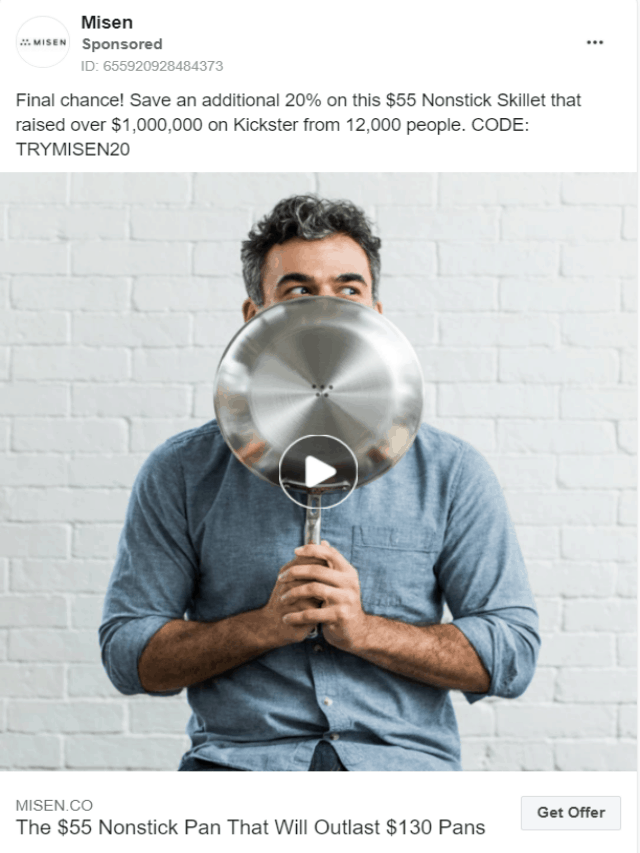
In addition, you can customize retargeting campaigns to show the specific products or pages that someone viewed, making them even more relevant.
6 Statistics that demonstrate the strength of retargeting
We hope you're excited about retargeting already, but if you're not entirely convinced yet, here are some impressive statistics:
- Retargeting ads are 76% more likely to get clicks than regular display ads (Source)
- Retargeting ads lead to a 1,046% increase in branded search (Source)
- Website visitors who are retargeted are more likely to convert by 43% (Source)
- Three out of five US buyers notice ads for products they viewed on other sites (Source)
- The click-through rate (CTR) of a retargeted ad is 10x higher than the CTR of a typical display ad (Source)
- 46% of marketing professionals believe retargeting is one of the most overlooked online marketing methods (Source)
And this is why so many successful dropshipping stores use retargeting as part of their marketing strategy! (Here is an example.)
How do you set up a Facebook Ad retargeting campaign? (5 Steps)
Excited to set up your Facebook Ad retargeting campaign? Awesome!
But first, you should know that Facebook Ad retargeting is not for everyone.
If you've just started running your store and don't have any sales yet, retargeting might not be too practical for you simply because you don't have as much data yet!
So, here's what we recommend to have before setting up your retargeting campaign:
- Required: You've set up your Meta Pixel. (Learn how in this article if you didn't do it yet.)
- Recommended for ad engagement retargeting: At least 10,000 views on your Facebook video ad in the last 60 days.
- Recommended for view content retargeting: At least 2,000 website visits in the last 60 days.
- Recommended for add to cart retargeting: At least 1,000 add to carts in the last 90 days.
- Recommended for initiate checkout retargeting: At least 1,000 initiate checkouts in the last 90 days.
Basically, when you're retargeting, you will target a group of people in a specific section of the ecommerce purchase funnel. However, if there are only 20 people in that group, the retargeting ads won't be efficient.
When setting the targeting of your Facebook Ads, the minimum audience size is 100 people, but Facebook recommends a minimum of 1,000.
The higher, the better, which is why we recommend having sufficient data on your Meta Pixel before you start retargeting!
Tip: If you don't have the recommended data yet, it's better to focus on your general Facebook Ads instead of the retargeting ads. Check out this article here to learn how to take your Facebook Ads to the next level!
Ready to start creating your retargeting campaigns now? Let's go!
1. Set up a custom audience in the Ads Manager
The first step of setting up a retargeting campaign is to create the audiences that you're going to (re)target.
You can do this from the Audiences section of the Ads Manager.
Once there, you will see a blue button in the top-left of the screen named ‘Create Audience.'
Click that button, and you will be able to choose a custom audience source:

A custom audience is a group of users who have taken specific actions on your website or Facebook page.
Here are some popular custom audiences to retarget, sorted from most to least accessible (remember, the more data, the better your retargeting ads will perform):
- Source: Video (Facebook video ad views). You can retarget people based on how long they've watched your video. For instance, only people who watched for at least ten seconds, or at least 25% of the video.
- Source: Website (Website visitors). Here, you can also choose only to include people who've visited your website for a specific time or only those who saw a specific (product) page.
- Source: Website (Add to carts). You can select everyone who added a product to their carts.
- Source: Website (Initiate checkouts). You can select everyone who initiated a checkout on your store.
- Source: Customer list. For example, on Shopify, you have a list of customers that includes their names, phone numbers, email addresses, etc. Facebook can match this information to Facebook profiles and retarget them.
Creating a custom audience is pretty simple. Simply select one of the above sources, set the retention period (spoiler: we'll have a tip about this later in the article), give the audience a name, and click the ‘Create audience' button!
2. Create a new ad campaign in the Ads Manager
Once your custom audience is set up, it's time to create the retargeting ad campaign!
First, head to the Campaigns section in the Ads Manager.
Next up, it's time to follow the standard steps of creating a new Facebook Ad campaign.
Considering you probably have some data on your Meta Pixel already, we'll go over this process swiftly. But if you want a more detailed explanation, you can check out this article here!
So, start off by clicking the green ‘Create' button, select ‘Sales' as your campaign objective, and give the campaign an appropriate name:

After clicking ‘Continue,' you can choose an Advantage+ shopping or Manual sales campaign.
Advantage+ shopping is a relatively new feature of Facebook Ads. It was designed as an attempt to optimize your ad's performance by giving more control to Meta's machine-learning algorithm.
Basically, Advantage+ shopping can be a good alternative to the ‘traditional' Facebook retargeting campaigns, and we will discuss them later in this article.
However, when you choose Advantage+ shopping, you won't be able to select the custom audience(s) you've just built, so we will go ahead with the Manual sales campaign for now!

Next up, continue setting up your ad as you're used to.
For the budget, we recommend setting it on the campaign level. It's hard to quantify the exact budget you should set, and you should always do some testing with it.
The more data you have, the higher you can set the budget. We typically recommend putting it at 5-10% of your total Facebook Ads budget.
3. Choose your target audience
Continuing on the ad set level of your campaign, set the conversion location to ‘Website' and the conversion event to ‘Purchase.'
Once you arrive at the ‘Audience' section, select the custom audience you created in step one.
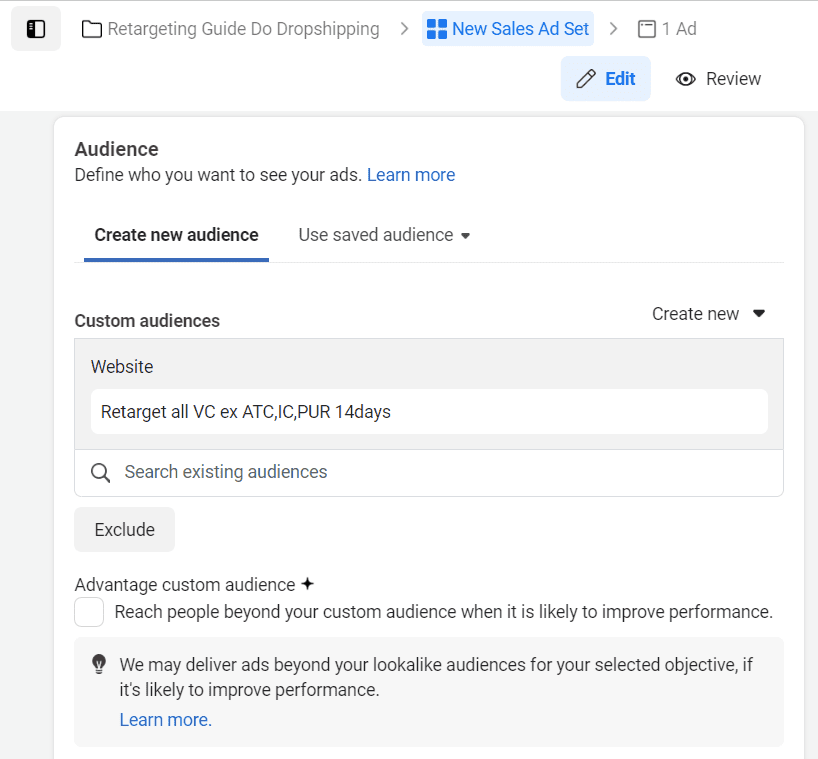
You will also see an option called ‘Advantage custom audience.'
This is the rebranded version of the old ‘Detailed Targeting Expansion' option, which basically gives Facebook permission to target people beyond your custom audience.
Since Meta's algorithms have improved dramatically over the last few years, this can be a good option to enhance the performance of your ads.
However, for a retargeting campaign, we recommend turning it off.
The retargeting ads you create will be specific to your custom audience and won't make much sense to others, so why would you target others with them?
For the other settings in the Audience section, keep your targeting as broad as possible to be able to target as many people as possible in your custom audience:
- Set the locations to all countries of your target audience. (Check out the best countries to target as a dropshipper in this article)
- Set the age range to 18 – 65+.
- Select ‘All genders.'
- Don't include demographics, interests, or behaviors in the detailed targeting section.
- Set languages to ‘All.'
The next option determines the placements of your ad(s).
For a retargeting campaign, we would select ‘Advantage+ placements' because it increases the likelihood of your ads being delivered to your custom audiences. (Sometimes, with small custom audiences, Meta may have issues delivering the ads on Facebook only.)

4. Design and launch your ad
Once you have chosen your target audience, you can design and launch your ad by following the prompts in the Ads Manager.
As always, you can choose your ad's format, primary text, headline, and call to action.
While creating the ad, keep the goal of retargeting in mind.
You want to nudge your target audience back to your website!
The best way to do that is to create an ad that grabs attention (step 1) and gives a reason to return to your store (step 2).
Here's how to create a retargeting ad that grabs people's attention:
- Call people out on their actions. Don't use your typical ad description. Instead, tell them what they've done. For example: ‘Hey! You've left something in your cart!'
- Show the product they were interested in. To maximize the chances of grabbing people's attention, use a different video or image than what they've seen so far.
And here are some ways to give people a reason to return to your store:
- Make them an offer. The most effective way to get someone to click on your retargeting ad is when you give them a discount code!
- Add a testimonial. Many times, people will search for a product review before purchasing it. Adding a testimonial to your retargeting ad can remind your audience that others love your product!
- Remind them of your terms. For instance, you can mention that you offer free shipping, 30-day free returns, and accept PayPal. Facebook's info labels are an excellent feature for this, which you can activate from the ad level of your campaign.

Here are some great examples to give you some inspiration for creating your retargeting ad.
First is Madewell, who reminds visitors of their free shipping and returns:

Next up is REI, with a cleverly-worded ad that definitely grabs the attention:
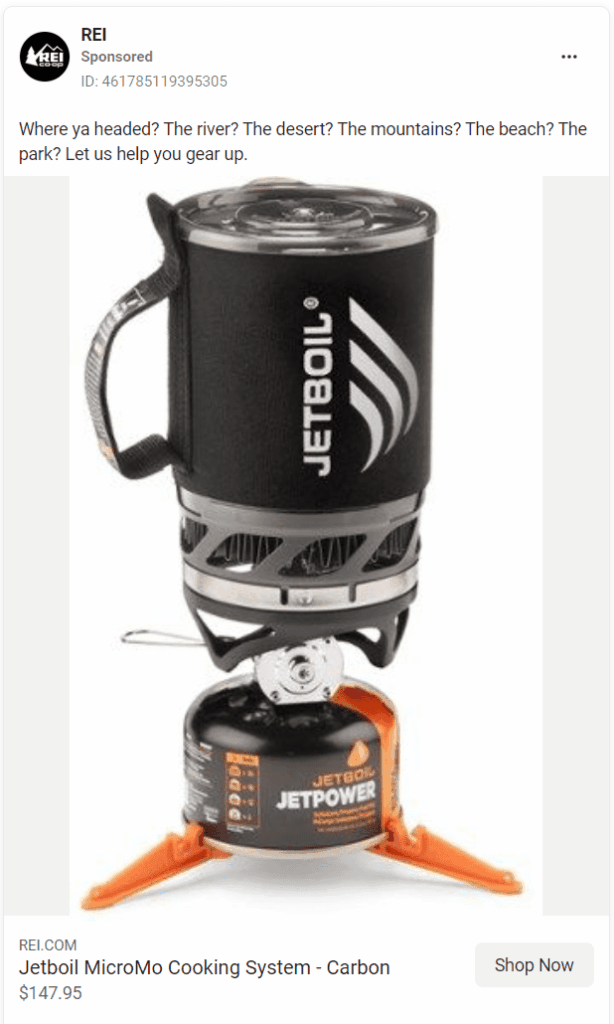
And lastly is Everlane, who smartly offers a little discount code:
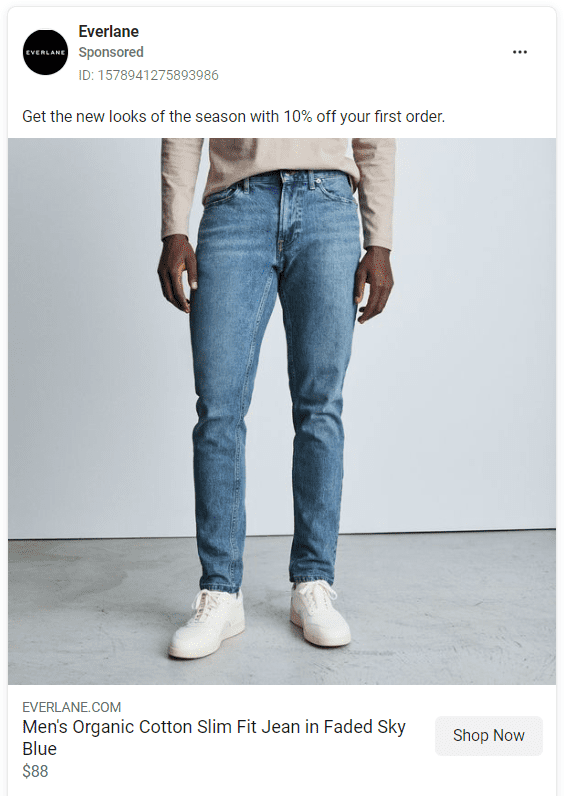
When you are ready to launch your ad, click the ‘Publish' button to make it live!
5. Keep an eye on the metrics and adjusts the campaign accordingly
After launching your retargeting campaign, it's important to remember that you're not done yet.
Running great Facebook Ads is an iterative process that requires continuous adjustments.
So, once you launch your campaign, there are a few things you should keep an eye on.
The first is the Frequency metric. This metric shows how often people saw your ad on average in a given time. It can indicate if you are over- or underserving the ads. Or, in other words, if your budget is too high or low.
If you see that the frequency is below one, you can try to increase the budget to reach more of your audience.
However, if you see that the frequency is high (for example, above four), you can reduce your budget slightly to avoid ‘wasting' it.
Setting your retargeting budget too high is one of the fastest ways to create Facebook Ad fatigue!

Next up, if you selected Advantage+ placements during your ad setup, it can be worthwhile to break down your metrics based on their placement.
This way, you can check if your conversions come from a particular placement, and if that's the case, you can adjust your ad placements accordingly!
You can analyze your ads' performance by placement by going to ‘Breakdown' -> ‘By Delivery' -> ‘Placement.'
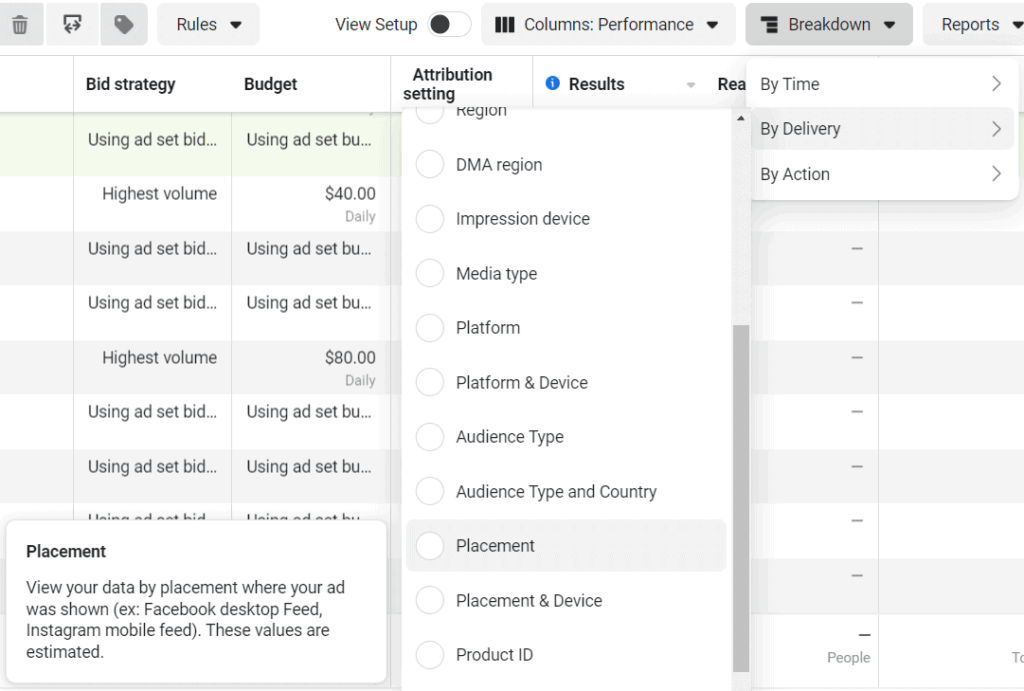
Last but not least, remember to keep a close eye on your return on ad spend (ROAS). This is one of the most important Facebook Ad metrics, as it basically tells you how much revenue you're getting for each dollar invested in ads.
And remember, retargeting campaigns are often regarded as having the highest ROAS out of any type of Facebook Ad, but that’s only the case if you can handle the budget carefully!
3 Tips to create more effective retargeting ads for your dropshipping store
Here are three of our top tips for making your Facebook Ad retargeting campaign even more effective:
1. Ensure the retargeting ads are highly-relevant to the audience
The most effective retargeting campaigns show relevant and interesting ads to the targeted users. So, ensure that your ads are aligned with the interests and needs of your target audience.
For example, if someone has been shopping for a cat toy on your pet niche dropshipping store, targeting them with a dog toy wouldn't be too effective.
So, always try to show your target audience the product they've interacted with most.
This isn't too difficult if you have a one-product or a small niche store.
But how do you deal with this if you have tens or hundreds of products in your catalog?
In that case, it may be better to use an Advantage+ shopping campaign (instead of the manual sales campaign).
Together with Advantage+ catalog ads (which were previously called dynamic ads), Meta created a feature that allows you to generate retargeting ads automatically:

As you can see, you can retarget people who've viewed your product page or added the product to the cart and customize their time frame. There are even options for upselling or cross-selling!
While these features look very nice and might work great for large-catalog stores, the downside is that they're less customizable.
For example, there is no option to retarget people who've initiated checkout, and your ad descriptions themselves won't be as relevant as they can be as they're auto-generated.
On the other hand, it is a fantastic time saver, and you will be sure that the right audience gets to see the product that's most relevant to them!
2. Consider the type of product you're selling when setting the custom audience timeframe
Whether setting up your ads automatically or manually, you will have to select a timeframe for both of them.
But what's a reasonable timeframe to choose?
Well, one strategy to think of an adequate timeframe is to consider the type of product you're selling.
For example, for low-ticket products that are often impulse-purchased, it's often better to set the timeframe to 30 days or less. For these products, people don't need a lot of time to think about whether they want them or not.

However, for high-ticket products that people tend to think about more before they make the purchase, you could set a 180-day or even 365-day window.
For example, if you're selling a $3,000 queen-sized bed, you can't expect someone to purchase it after seeing just one Facebook Ad of it, right?

3. Make sure your custom audiences don't overlap
Remember the ecommerce purchase funnel we showed you at the start?
If not, here it is again:

It's common to create a custom audience of a part of this funnel for your retargeting campaigns.
But when you do that and create multiple custom audiences, make sure they don't overlap.
For example, if you're creating a retargeting campaign for people who've added a product to their carts, make sure to exclude those who also initiated the checkout:
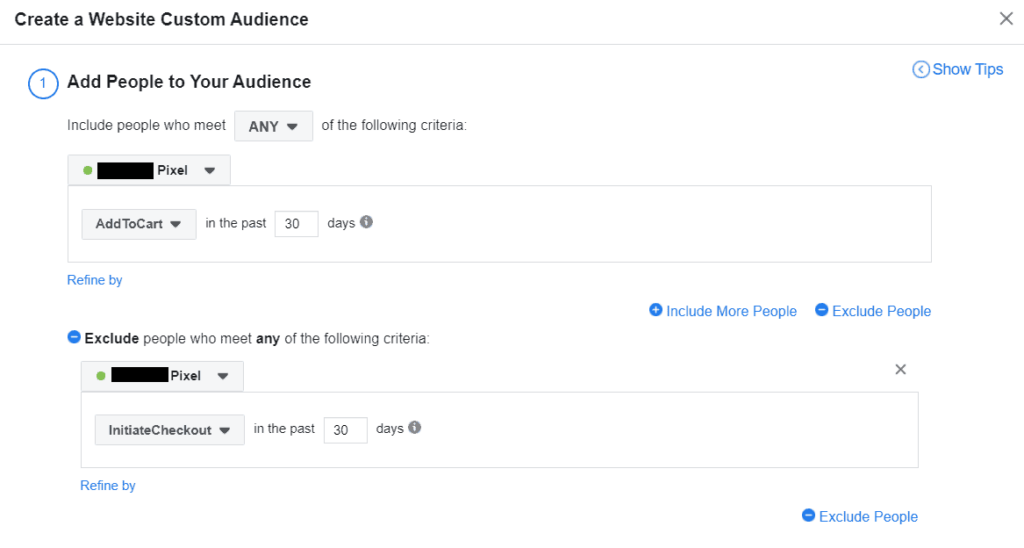
When running retargeting campaigns with overlapping audiences, your ads will be less relevant, and it can be unclear which audience yields the best results!
Does Facebook Ad retargeting still work in 2023? (iOS 14 update)
Unfortunately, Facebook Ad retargeting won't always be as effective as it once was.
In September 2020, Apple released a new update called iOS 14 that allowed users to opt-out of app tracking.
Since then, Facebook could no longer track those iPhone users once they left the Facebook app.
The result is that the custom audiences of your retargeting campaigns get smaller, making the campaigns less effective.
However, as with any challenge, there is a solution. So, here are some things you can try to minimize the iOS 14 update from affecting you:
- Try to focus more on Meta's audience sources, like the people who visited your Facebook page or Instagram account.
- Make your custom audiences less specific. For example, target all website visitors instead of only the add to carts.
- Increase the timeframe of your custom audiences to increase their size.
- Focus on building an email list and use it for retargeting.
All in all, don't stress out too much about this. Facebook Ad retargeting still works in 2023!
Summary
Before we go to the final verdict, we've created a quick summary of this article for you, so you can easily remember it:
- Facebook Ad retargeting is an effective strategy to help increase sales.
- Retargeting allows store owners to target people who have already interacted with the business, such as those who have added items to their cart but did not complete the purchase.
- Retargeting ads have higher click-through rates (CTR) and conversion rates when compared with other types of ads.
- Setting up a Facebook Ad retargeting campaign requires having sufficient data on your Meta Pixel.
- To create effective retargeting ads, ensure they are relevant to the audience, consider the type of product for your timeframe, and ensure your custom audiences don't overlap.
- Despite the iOS 14 update, Facebook Ad retargeting still works in 2023!
Conclusion
Now that you know all about Facebook Ad retargeting, it’s time to get out there and start testing it yourself.
Retargeting ads are incredibly effective in boosting sales and increasing brand awareness.
And even though there have been some changes recently with the release of iOS 14, Facebook Ad retargeting is still a fantastic marketing tool – one that any ecommerce business should leverage to stay ahead of the competition!
Have you used Facebook Ad retargeting in your dropshipping business? What was your experience?
Let us know in the comments below!
Want to learn more about dropshipping?
Ready to move your dropshipping store to the next level? Check out the articles below:
- 11 Reasons to Use Facebook Ads for Your Ecommerce Store
- Marketing for Dropshipping: How to Pick the Right Method
- 9 Dropshipping Marketing Strategy Tips to Grow Your Business
Plus, don’t forget to check out our in-depth how to start with Facebook Ads for ecommerce guide here!














